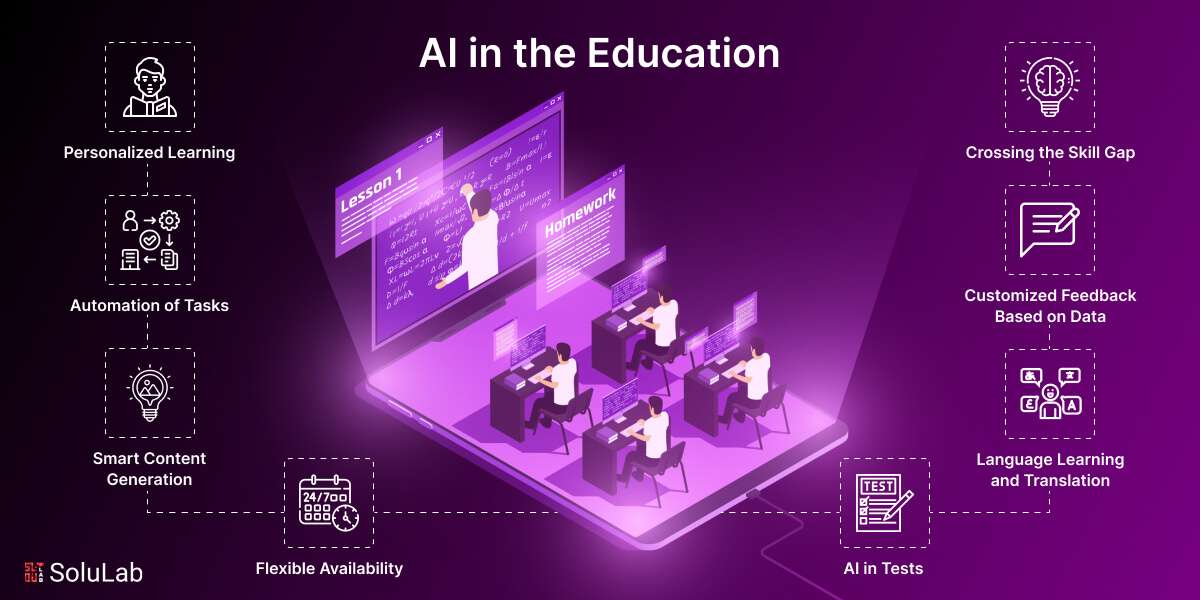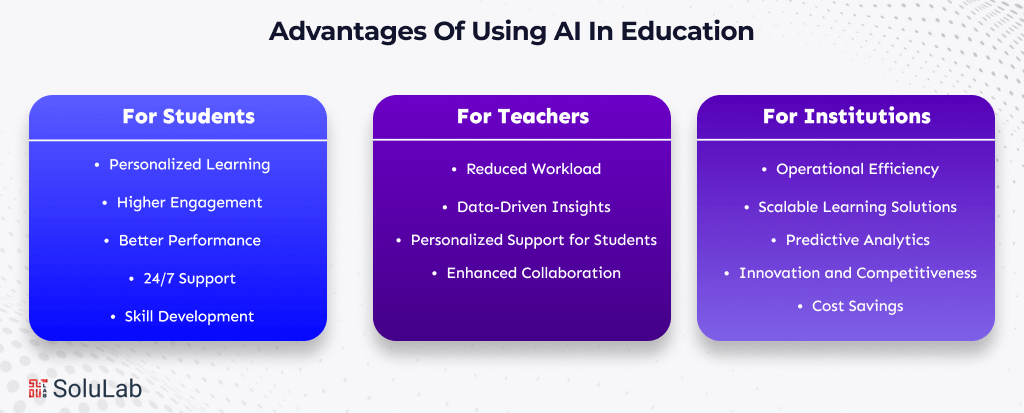
Every student learns differently. Some grasp concepts quickly, while others need more time and support to understand a topic. Traditional classroom settings often struggle to address these differences, resulting in learning gaps.
AI can analyze each student’s learning patterns, strengths, and weaknesses, and adapt the content accordingly. Whether it’s breaking down a difficult concept into simpler parts or adjusting the pace of lessons, AI brings personalized learning to the forefront.
This blog examines how AI is transforming the education industry—from personalized learning experiences to intelligent classroom management—and why its role is poised to grow even stronger.
What is AI in Education?
AI in education refers to the use of artificial intelligence technologies to enhance the learning experience, support teachers, and streamline administrative tasks. It allows machines to analyze data, make decisions, and provide personalized guidance to students, creating a smarter and more adaptive educational environment.
By integrating AI, schools and educational platforms can provide a more engaging, efficient, and personalized learning experience, helping students achieve better outcomes while reducing teachers’ administrative burden.
Traditional Ed-tech Vs. AI-driven Solution
| Aspect | Traditional Ed-Tech | AI-Driven Solutions |
| Content Delivery | Static, one-size-fits-all lessons | Adaptive, personalized learning paths |
| Feedback | Manual, delayed feedback from teachers | Instant, data-driven feedback and guidance |
| Assessment | Paper-based or standard digital tests | Automated grading, predictive analytics for performance |
| Teacher Role | Manually adjusts lessons and tracks progress | Focuses on strategy; AI handles repetitive tasks |
| Learning Experience | Uniform for all students | Tailored to each student’s pace and needs |
| Decision Making | Based on limited data and observation | Data-driven insights for proactive interventions |
Key Impact Areas of AI in Education
AI is no longer just a futuristic concept; it is actively transforming education by making learning more personalized, efficient, and engaging. Here are the key areas where AI is making a real difference:
1. Personalized Learning
AI systems can analyze individual student performance, learning styles, and pace to deliver customized lessons. Platforms like DreamBox and Squirrel AI adapt content in real-time, ensuring that each student receives material that suits their strengths and addresses their weaknesses. This level of personalization helps students stay engaged and learn more effectively, reducing the frustration of one-size-fits-all education.
2. Intelligent Tutoring & Assistance
AI-powered tutors provide 24/7 support, offering explanations, practice exercises, and instant feedback. Unlike traditional tutoring, AI tutors never tire and can handle unlimited students simultaneously. Tools like Carnegie Learning’s MATHia offer interactive problem-solving sessions that simulate one-on-one teacher attention, helping students grasp complex concepts outside classroom hours.
3. Automation of Tasks
AI automates repetitive administrative and educational tasks, saving teachers significant time. Automated grading, attendance tracking, and even basic lesson planning are now possible through AI platforms like Gradescope. For students managing multiple assignments, seeking guidance online, like conclusion generator tools, can complement AI tools by ensuring high-quality academic output.
4. Predictive Analytics
AI can analyze historical and real-time student data to predict learning gaps, performance trends, and even the risk of dropouts. This empowers educators to intervene proactively, offering extra support where needed. Predictive insights help schools and institutions allocate resources efficiently and design targeted programs that maximize student success.
Read More: AI In Practical Science Learning
5. Enhanced Engagement
AI integrates gamification, adaptive quizzes, and VR/AR experiences to make learning more engaging. Tools such as AI-driven simulations allow students to interact with concepts in immersive ways, turning abstract subjects like science and history into hands-on experiences. This approach not only increases motivation but also reinforces knowledge retention.
6. Streamlined Administrative Management
Beyond classroom learning, AI helps educational institutions optimize operations. From scheduling classes to managing student records and predicting enrollment trends, AI ensures smoother workflows, reduces human error, and allows administrators to focus on strategic planning and improving the learning environment.
7. Language Learning and Translation
AI-powered apps like Duolingo adapt lessons based on individual progress and provide instant translation support. This enables learners to practice languages at their own pace while receiving personalized feedback.
8. Chatbots for Student Support
AI-powered chatbots assist students with enrollment, course selection, scholarship guidance, and general queries. For example, Georgia State University uses chatbots to answer student questions and guide them through administrative procedures, increasing efficiency and engagement.
Key Advantages of Using AI in Education

AI is modernizing education by offering tailored solutions for students, teachers, and institutions. Here’s a detailed look at its key benefits:
For Students:
- Personalized Learning: AI analyzes each student’s strengths, weaknesses, and learning pace to deliver customized lessons and practice exercises. This ensures students get the support they need where it matters most.
- Higher Engagement: AI-powered gamification, interactive lessons, and VR/AR experiences make learning more immersive and fun, keeping students motivated and focused.
- Better Performance: Continuous feedback from AI tutors and adaptive platforms allows students to track progress, address gaps, and improve learning outcomes effectively.
- 24/7 Support: AI tutors and chatbots provide guidance anytime, helping students clarify doubts outside traditional classroom hours.
- Skill Development: AI tools can identify skill gaps and recommend learning modules, preparing students for real-world challenges and future careers.
For Teachers:
- Reduced Workload: Automation of grading, attendance tracking, and report generation saves significant time, allowing teachers to focus on mentoring and creative lesson planning.
- Data-Driven Insights: AI analyzes student performance trends, identifying areas where intervention is needed and helping teachers make informed decisions.
- Personalized Support for Students: With insights provided by AI, teachers can tailor instruction to individual needs, improving overall classroom effectiveness.
- Enhanced Collaboration: AI tools can assist in curriculum development and facilitate communication with students and parents more efficiently.
For Institutions:
- Operational Efficiency: AI streamlines administrative tasks such as scheduling, record management, and resource allocation, reducing errors and overhead costs.
- Scalable Learning Solutions: Institutions can deliver personalized learning experiences to large numbers of students without compromising quality.
- Predictive Analytics: AI helps predict student performance trends, enrollment patterns, and potential dropouts, allowing institutions to plan interventions proactively.
- Innovation and Competitiveness: Integrating AI enhances the institution’s reputation as a modern, tech-forward learning environment, attracting students and educators.
- Cost Savings: By automating repetitive administrative and teaching tasks, AI reduces the need for extensive human resources, optimizing budgets while maintaining educational quality.
Real-World Examples of AI in Education

AI is no longer experimental in education—it’s actively driving measurable improvements in learning outcomes, engagement, and operational efficiency across schools, universities, and ed-tech platforms.
1. Georgia State University: AI Chatbot for Student Support
Implementation: Georgia State University uses an AI-powered chatbot named Pounce to assist students with enrollment, registration, and financial aid queries.
Impact: Pounce answered over 100,000 questions in its first year, reducing human staff workload and improving student response time from days to seconds.
2. Carnegie Learning: AI-Powered Math Tutoring
Implementation: MATHia, an AI-driven tutoring system, provides personalized math lessons for middle and high school students.
Impact: Schools reported a 20% improvement in student test scores and increased engagement in mathematics compared to traditional methods.
3. Squirrel AI Learning: Adaptive Learning Platform
Implementation: This Chinese ed-tech company uses AI to create adaptive learning paths for K–12 students, adjusting lessons based on individual performance.
Impact: Students using Squirrel AI showed a 30–50% faster learning progress in core subjects than peers using standard curricula.
4. DreamBox Learning: Personalized Math Instruction
Implementation: DreamBox uses AI to tailor online math lessons for elementary and middle school students.
Impact: Studies found that students using DreamBox for just 14 hours experienced a 60% increase in math proficiency growth compared to non-users.
5. BYJU’S: AI-Powered Learning App
Implementation: BYJU’S uses AI to recommend personalized content, quizzes, and practice sessions for millions of students across India.
Impact: Students report improved retention and performance, while the platform achieves higher engagement rates, with users spending more time on personalized learning modules.
6. Coursera: AI for Course Recommendations
Implementation: Coursera uses AI algorithms to suggest courses and learning paths based on student preferences and past activity.
Impact: Personalized recommendations led to a significant increase in course completion rates, helping learners achieve certifications faster.
Future of AI in Education
The future of AI in education is changing how we teach, learn, and evaluate. As more AI tools are coming every other day, they will bring deeper personalization, smarter automation, and broader accessibility to learners around the world.
In the coming years, AI will move beyond just content delivery—it will understand emotions, learning preferences, and cognitive abilities to create hyper-personalized learning journeys. Intelligent virtual tutors will provide instant support, feedback, and motivation.
AI will also help educators make data-driven decisions by analyzing performance patterns, predicting outcomes, and suggesting intervention strategies. Tasks like grading, scheduling, and reporting will be automated, allowing teachers to focus on creativity and human connection in the classroom.
Furthermore, AI will play a vital role in inclusive education. With tools like speech-to-text, real-time translation, and learning aids for neurodivergent students, education will become more accessible and equitable.
Concluding Remarks
AI is rapidly transforming the education sector, making learning more personalized, engaging, and accessible. From AI tutors and adaptive learning platforms to immersive VR classrooms and predictive analytics, the possibilities are endless. Students gain tailored learning experiences, teachers can focus on mentorship and strategy, and institutions achieve operational efficiency and global scalability.
For educational institutions and ed-tech companies looking to harness the power of AI, partnering with a reliable AI development company is crucial. SoluLab specializes in building AI-driven educational solutions—from personalized learning platforms and intelligent tutoring systems to VR/AR classrooms and predictive analytics tools.
Partner with us to create innovative AI solutions that make learning smarter!
FAQs
1. How does AI improve student engagement?
Through gamification, interactive quizzes, VR/AR lessons, and adaptive content, AI makes learning more immersive, motivating students to actively participate and retain knowledge better.
2. Can AI replace teachers?
No. AI acts as an assistant, automating repetitive tasks and providing personalized support, while teachers focus on mentorship, critical thinking, and creative teaching.
3. Is AI in education accessible for small schools or institutions?
Yes. Many AI-powered platforms are scalable and cloud-based, allowing even small schools or ed-tech startups to implement personalized learning and administrative automation affordably.
4. Can AI support inclusive and multilingual education?
Absolutely. AI tools can provide real-time translations, text-to-speech, adaptive content, and accessibility features for students with disabilities, making education more inclusive.
5. How can a business or institution implement AI in education?
Partnering with experts like SoluLab can help design and integrate AI-powered solutions, from personalized learning platforms to intelligent tutoring systems and administrative automation.






